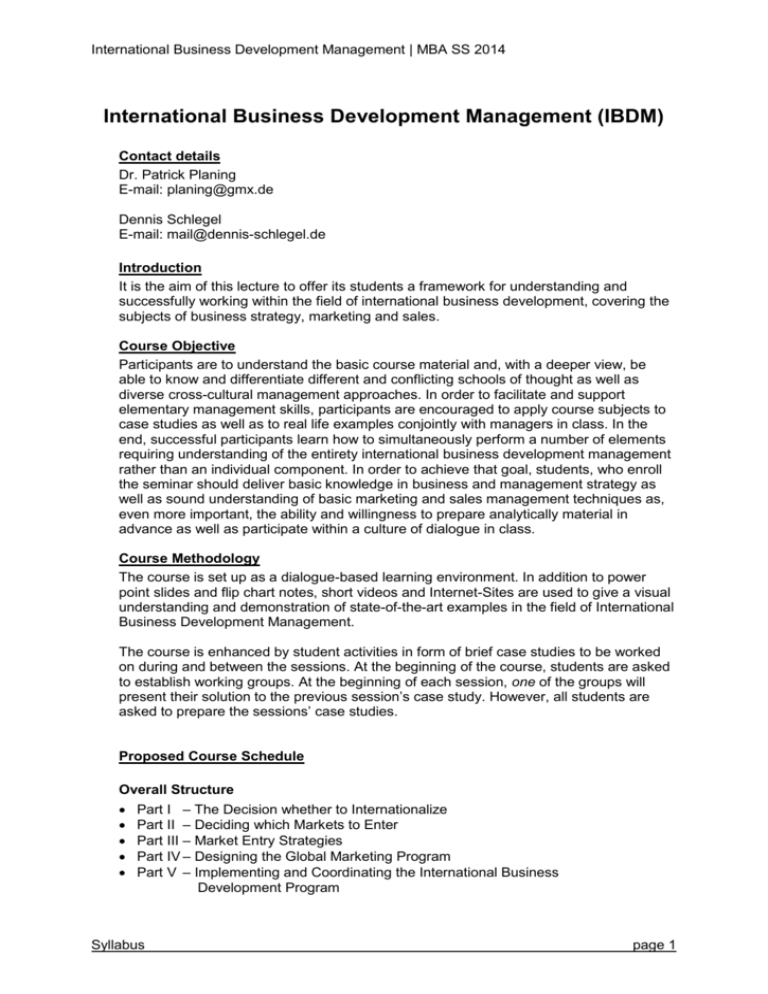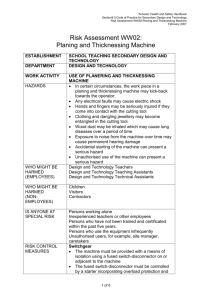International Business Development Management
advertisement

International Business Development Management | MBA SS 2014 International Business Development Management (IBDM) Contact details Dr. Patrick Planing E-mail: planing@gmx.de Dennis Schlegel E-mail: mail@dennis-schlegel.de Introduction It is the aim of this lecture to offer its students a framework for understanding and successfully working within the field of international business development, covering the subjects of business strategy, marketing and sales. Course Objective Participants are to understand the basic course material and, with a deeper view, be able to know and differentiate different and conflicting schools of thought as well as diverse cross-cultural management approaches. In order to facilitate and support elementary management skills, participants are encouraged to apply course subjects to case studies as well as to real life examples conjointly with managers in class. In the end, successful participants learn how to simultaneously perform a number of elements requiring understanding of the entirety international business development management rather than an individual component. In order to achieve that goal, students, who enroll the seminar should deliver basic knowledge in business and management strategy as well as sound understanding of basic marketing and sales management techniques as, even more important, the ability and willingness to prepare analytically material in advance as well as participate within a culture of dialogue in class. Course Methodology The course is set up as a dialogue-based learning environment. In addition to power point slides and flip chart notes, short videos and Internet-Sites are used to give a visual understanding and demonstration of state-of-the-art examples in the field of International Business Development Management. The course is enhanced by student activities in form of brief case studies to be worked on during and between the sessions. At the beginning of the course, students are asked to establish working groups. At the beginning of each session, one of the groups will present their solution to the previous session’s case study. However, all students are asked to prepare the sessions’ case studies. Proposed Course Schedule Overall Structure Part I – The Decision whether to Internationalize Part II – Deciding which Markets to Enter Part III – Market Entry Strategies Part IV – Designing the Global Marketing Program Part V – Implementing and Coordinating the International Business Development Program Syllabus page 1 International Business Development Management | MBA SS 2014 Session-by-session topics/activities with required readings and coursework Part I 1 (03-21) 2 (03-28) Part II 3 (03-31) 4 (04-04) Part III 5 (04-11) 6 (05-02) Part IV 7 (05-09) Syllabus The Decision whether to Internationalize Introduction to International Text: Chapter 1, 2 Business Development Case Study: Course structure and learning Hunter Boots objectives (Case 1.2) The internationalization process Internationalization as a managerial decision Internationalization Theories/ Text: Chapter 3, 4 Competitive Models – Three theories explaining firms’ Case Study: Microsoft ‘Surface’ tablet internationalization process (Case 4.2) Uppsala model Transaction cost theory The network model – Micro and macro analysis of competitiveness The Porter Diamond Porter’s Five Forces Value Chain Analysis Deciding which Markets to Enter Political, economic and socioText : Chapter 6 and 7 cultural environment Case Study: Political risk analysis Gerolsteiner Trade barriers (Case II.3) Major trading blocks Cultural dimensions International market selection Text : Chapter 8 International market selection Case Study: process Porsche MACS Matrix (Case II.4) Developing a global product/market portfolio Market Entry Strategies Choice of market entry mode Text : Chapter 9, 10, 11 Overview of entry modes Case Study: Factors influencing the choice of Parle Products entry mode (Case 10.2) Export entry modes Choice of market entry mode Intermediate entry modes Hierarchical modes Text : Chapter 12 Lecturer: Planing / Schlegel Schlegel Planing Planing Schlegel Schlegel Case Study: Polo Ralph Lauren (Case 12.1) Designing the Global Marketing Program Product decisions Text : Chapter 14 Developing international product Case Study: strategies Dyson The product life cycle in an Planing page 2 International Business Development Management | MBA SS 2014 international context 8 (05-15) 9 (05-16) 10 (06-18) 11 (06-20) Part V 12 (06-27) (xx-xx) Pricing decisions Developing international pricing strategies Current trends: implications of the Internet for pricing across borders (Case IV.3) Text : Chapter 15 Planing Case Study: Harley-Davidson (Case 15.1) Distribution decisions Text : Chapter 16 Planing Structure of the channel (intensive, Case Study: selective and exclusive) De Beers Managing and controlling (Case 16.1) distribution channels Most common export documents Internationalization of retailing Grey markets Communication decisions Text : Chapter 17 Planing The communication process Case Study: Communication tools: Morgan Motor Company Advertising, Public relations, (Case 17.2) Sales promotion, Direct marketing, Personal selling, Viral marketing Standardization versus adaptation strategies (examples Global Market Research Text : Chapter 5 Schlegel The role of marketing research in Case Study: the internationalization process Teepack Spezialmaschinen Research methods Current trends (e.g. Big Data, Web GmbH (Case 5.1) 2.0 / Social Media) Implementing and Coordinating the International Marketing Program Organization and control of the Text : Chapter 19 Schlegel international marketing program Different organization structures for different international activities Global Account Management Exam Documents for download The Syllabus and the lecture script are ready for download on the E-learning-Platform under http://elearning.hs-pforzheim.de. Please sign in with your name and your password, and go to lecture “International Business Development Management/IBDM” where you will find all the material. The course is mainly based on the textbook by Hollensen (see below). The recommended readings for each session are indicated in the table above. Assessment method The final grade will consist of the following: Exam at the end of the semester (90 minutes): Presentation of case studies (in groups) Syllabus 66% 33% page 3 International Business Development Management | MBA SS 2014 Please note that you have to pass the exam in order to pass the course! The exam will be held during lecture times in the assigned lecture room (if not given other notice beforehand). The exam will contain the theoretical background to International Marketing, but also the content of the case studies. Literature Key literature: Hollensen, S. (2014): Global Marketing, Pearson, 6th edition. Further recommendations: Easterby-Smith, M./ Thorpe, R./ Jackson, P. R. (2012): Management Research, Sage Publications, 4th edition. Kotler, P./ Keller, K. L. (2011): Marketing Management, Pearson Eductaion, 14th edition. Cateora, P./Gilly, M./Graham J. (2012): International marketing, McGraw-Hill, 16th international edition. Deresky, H. (2013): International Management. Managing Across Borders and Cultures, Pearson international edition, 8th edition. Doole, I./Lowe, R. (2012): International Marketing Strategy. Analysis, Development and Implementation, South-Western, 6th edition. Griffin, R. W./Pustay, M. W. (2009): International Business, Pearson international edition., 6th edition. Johansson, J. K. (2010): Global Marketing. Foreign Entry, Local Marketing & Global Management, McGraw-Hill, 5th international edition. Keegan, W./Green, M. (2013): Global Marketing, Pearson international Edition, 7th edition. Mühlbacher, H./Leihs, H./Dahringer, L. (2006): International Marketing, Thomson Learning, 3rd edition Syllabus page 4






